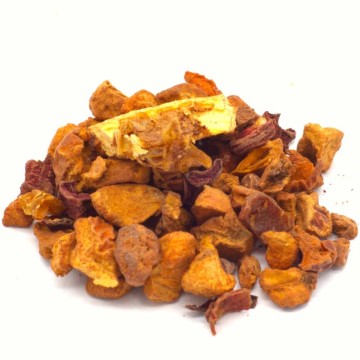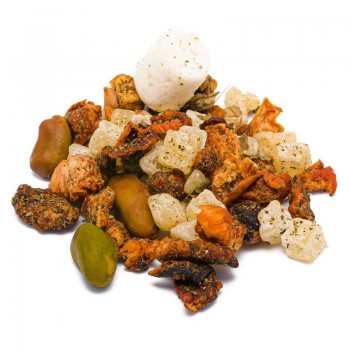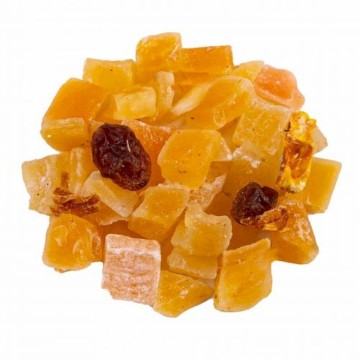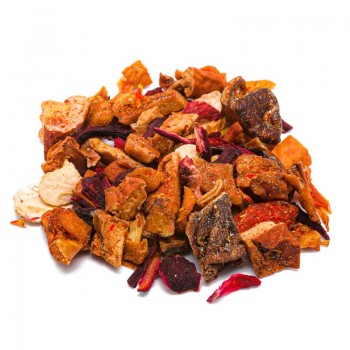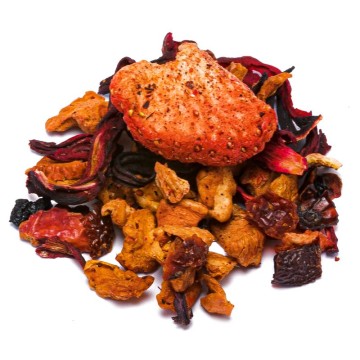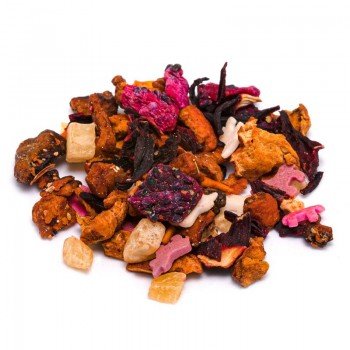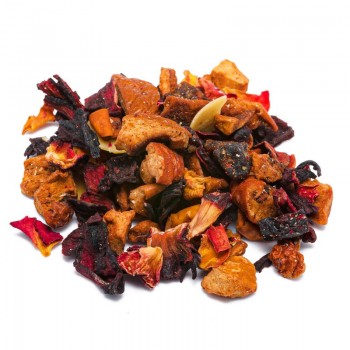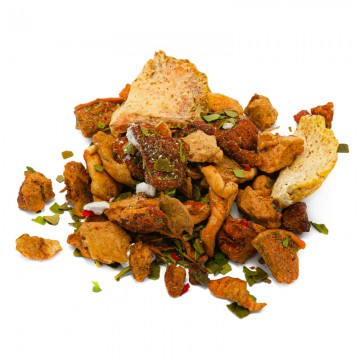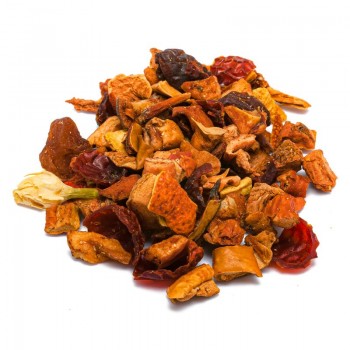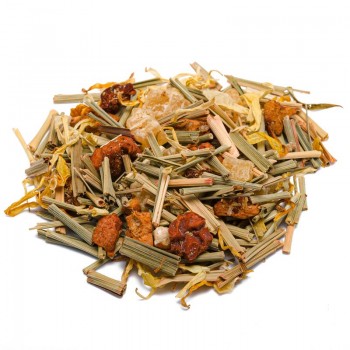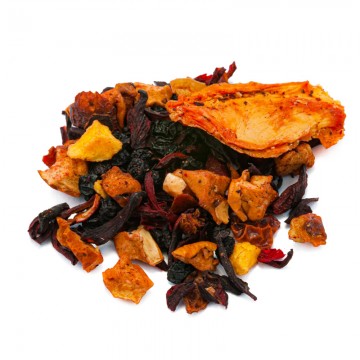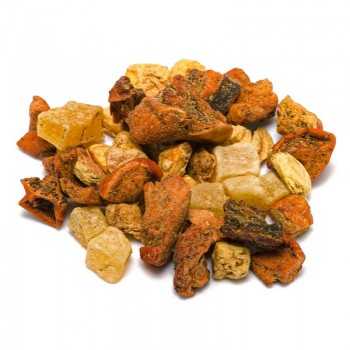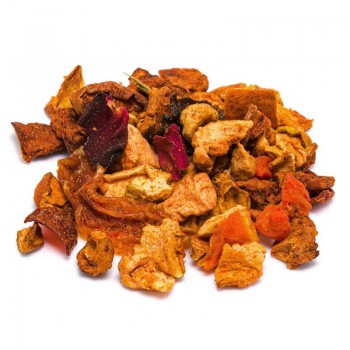Pleasant and rich in beneficial properties for the body, this infusion is naturally caffeine-free. A true summer dream, which arises from the combined goodness of melon and peach, also releasing aromas and flavors of exotic fruits such as papaya and pineapple. With a tropical floral touch of hibiscus and the delicate final note of cornflower. The balanced nuances of apple and the tart flavor of rosehip give the infusion substance and nutrient benefits. Its delicious and lively flavor allows you to smile again and face the day with a load of positivity.
Peach and melon infusion: properties and benefits
The elements in this blend give each sip nutritional principles that purify the body and aid digestion. The detox action is favored by various mineral salts and vitamins, such as those contained in melon (iron, calcium and phosphorus), which stimulate intestinal movements and free the kidneys from excess waste and toxins. The combination of pineapple, papaya and melon can promote protein digestion and a detoxifying, as well as refreshing, result.
It is an excellent infusion for people with digestive problems, who wish to improve intestinal transit with a tasty drink. Furthermore, the properties of pineapple are notoriously diuretic, facilitating the expulsion of excess fluids - a help for those suffering from water retention. The peach element adds minerals such as calcium and potassium, which come from the peach for a remineralizing and restorative effect. The peach and melon infusion shows a good presence of group B vitamins (especially in melon), vitamin A and vitamin C (rosehip, hibiscus, pineapple, peach, papaya), useful for well-being of our organism.
Origins and history of cultivation
The peach fruit probably originates from China, from where it spread to the Mediterranean countries and subsequently to other parts of Europe. The Spanish also brought the peach tree to America, and there is evidence of it already in the seventeenth century in Mexico. In its cultivation its characteristic must be respected, being a fruit tree with a relatively short lifespan. The peach orchards are replanted after 8-10 years, with particular attention to the climate.
The plants are intolerant to intense cold and cannot be grown at low temperatures, but they still do not develop well where winters are too mild (they require winter cooling). Today the peach tree is grown in the warm temperate regions of the Northern and Southern Hemispheres, with intense cultivation beginning in the twentieth century. The peach tree is considered one of the most important fruits for agricultural production in Italy, China, Spain and the United States.
Melons spread from centers of origin in Africa and then Asia to Europe and the Americas through trade and exploration. Already known 3000 years ago, the fruit was consumed by Sumerians, Assyrians, Egyptians and then Romans. Over time, many varieties have emerged, as hybridization of melons occurs frequently in nature. They are divided based on the yield, sweetness, consistency and color of the fruit. Some groups have a strong scent when ripe, and adapt to the hot, dry season. Other melon cultivars have evolved with late fruit ripening. The sweet melon found on the market today is part of the varieties we know and bring to the table. The best-known sweet orange-fleshed melon takes its name from the locality Cantalupo (Cantalupensis), where it was cultivated from a south-western Asian variety since the Middle Ages. Other varieties include netted melons (Reticulatus), Inodorus winter melons and Chito mango melons.
Fruits and flowers
The melon fruit comes from the Cucumis melo plant, a climber of the Cucurbitaceae family. Frost resistant, the plant still requires a warm climate. It develops large leaves and yellow flowers. The famous fruits are botanically a type of berry, known as pepo, and vary depending on the variety in terms of size, color, shape, texture and flavor of the pulp. Ripe cantaloupes and net melons exude a sweet fruity smell, while winter melons ripen late, becoming softer but not too sweet.
The peach plant is Prunus persica, which represents a species of the Rosaceae family. Peach trees are usually small to medium in size, rarely reaching 6 meters in height. Theleaves are glossy green, and flowers are usually pink - occasionally white. There are some varieties of the plant, grown for the succulent and sweet pulp of the fruits. Peaches usually appear red with yellow shades and various shades, with more or less intense colors in these shades. As fruits they are consumed fresh, dehydrated or freeze-dried.
The rosehip is the false fruit of some species of Rose, a perennial plant of the Rosaceae family. It often derives from Rosa Canina but also from Rugosa, Acicularis or Cinnamomea. There are thousands of cultivars, in the form of erect or climbing shrubs, and most species derive from Asia. The flowers change shape, size and color, while the rosehip always appears oval, fleshy and red. Rose hips represent the mature ovary that remains on the branch after the flower, and inside they contain approximately 3 small yellow-brown seeds.
The Malus domestica plant of the Rosaceae family gives us apples. It is a tree native to Asia, now widespread throughout the planet. The fruits vary in color and in many varieties, which distinguish apples by color, size and consistency of the pulp.
Ananas comosus is a not very tall plant, from the Bromeliaceae family. It grows best on well-drained soil, exposed to the sun and produces the famous fruits with a shape that resembles a pine cone. Pineapples are formed by the union of the flowers and berries of the plant, which create a single fruit.
The hibiscus plant, Hibiscus sabdariffa, belongs to the Malvaceae family. It grows in tropical and subtropical regions around the world. The calyx and flowers are used for hibiscus tea, as flavorings and colorings.
The Carica papaya is a tree of the Caricaceae family, from which the fruits derive - diversified in color between green, yellow, orange and pink. They can reach up to 30 cm and weigh 9 kg. It shows little branching, and reaches up to 10 meters in height with a warm or temperate temperature.
The cornflower is the flower of the annual plant Centaurea cyanus, of the Asteraceae family. It is a plant native to Europe, which often grows in cereal fields, in soil with good drainage. It gives flowers used for infusions, of different colors: intense blue, pink, purple, white.
Nutritional values of peach and melon infusion
The infusion is a source of mineral salts, especially potassium, zinc, calcium, magnesium, phosphorus. It gives various vitamins, mainly vitamin C and group B. How to use the ingredients in the infusion The infusion is obtained by inserting approximately 3-5 grams of the peach and melon mixture into a cup (250 ml) with water at 100 °C. Leave to infuse for 10 to 12 minutes before drinking. Add honey or sugar, if desired.
Peach and melon infusion: side effects and contraindications
Even if it brings benefits, to avoid unwanted effects it is necessary to respect the recommended doses and not exceed the consumption of the infusion for too long periods. Excessive intake can cause diarrhea, stomach pain, nausea, headache. Caution advised for pregnant or breastfeeding women.

![infuso pesca melone [Natura d'Oriente] infuso pesca melone [Natura d'Oriente]](https://www.naturadoriente.com/3535-large_default/infused-peach-melon.jpg)
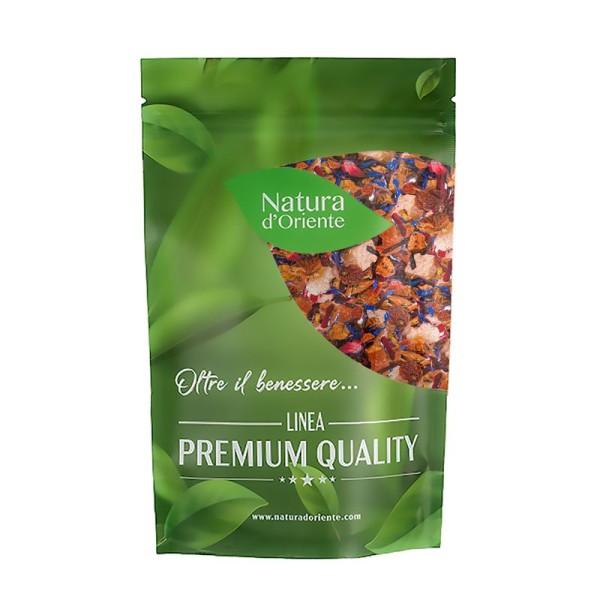



![infuso pesca melone [Natura d'Oriente] infuso pesca melone [Natura d'Oriente]](https://www.naturadoriente.com/3535-home_default/infused-peach-melon.jpg)




 No reward points for this product.
No reward points for this product.
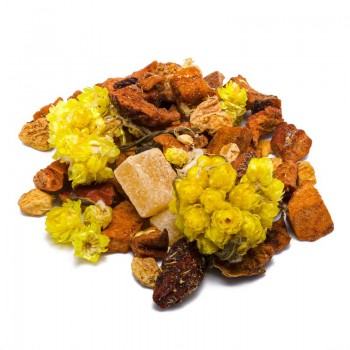
![infuso lime mirtilli rossi [Natura d'Oriente]](https://www.naturadoriente.com/3551-home_default/lime-infused-cranberries.jpg)
